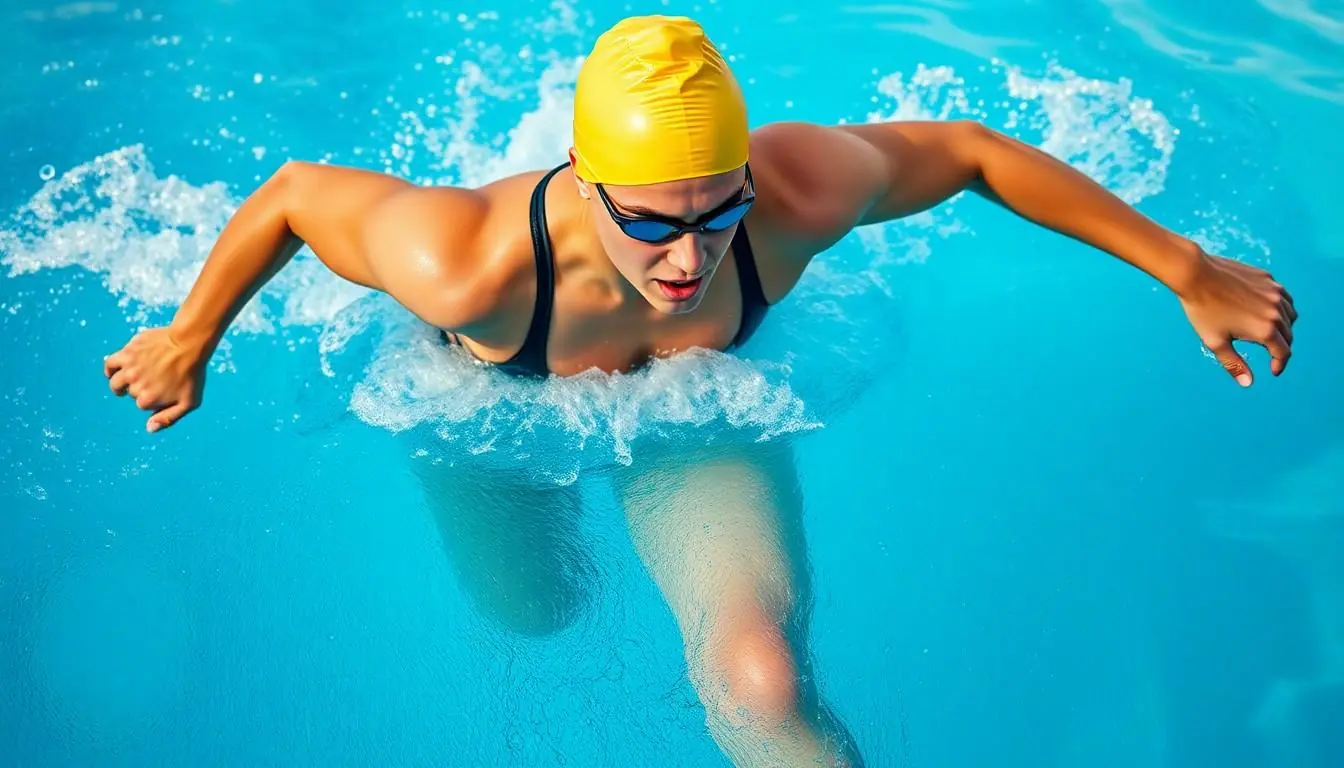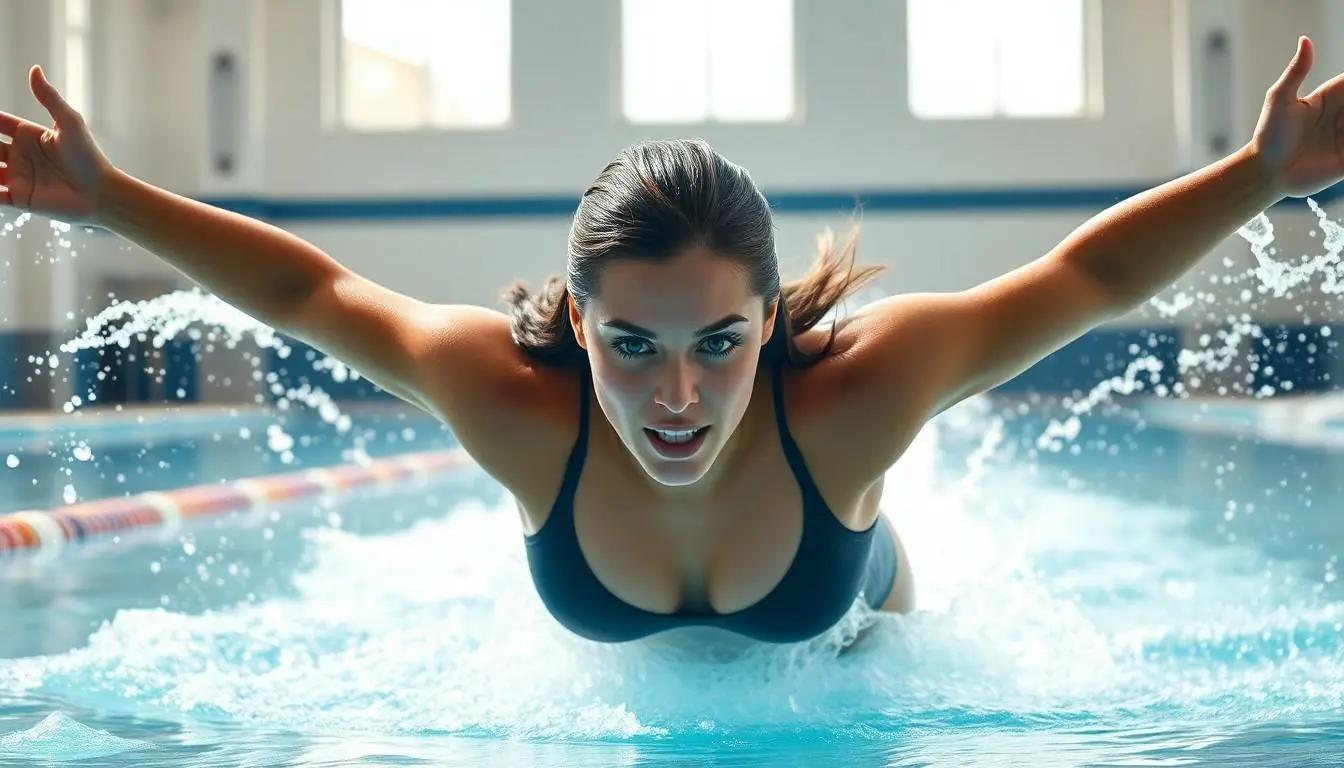Table of Contents
ToggleWhen it comes to muscle building, most people picture sweat-drenched gym sessions and heavy weights, but what if the secret to sculpting a stronger physique lies beneath the surface? That’s right—swimming isn’t just for mermaids and Olympic champions. It’s a full-body workout that can transform flabby into fabulous while keeping you cool and collected.
Can Swimming Build Muscle?
Swimming effectively builds muscle due to the resistance of water. Muscles engage throughout the entire body during each stroke and kick. Engaging multiple muscle groups leads to increased strength over time.
To illustrate, the arms strengthen through freestyle strokes, while the core engages during starts and turns. Training consistently in various strokes enhances overall muscle development.
Research indicates that swimming can increase lean muscle mass, especially when combined with a structured routine. It’s also known for enhancing endurance and flexibility, complementing traditional strength training.
Different swimming techniques target distinct muscle groups. The butterfly stroke emphasizes the chest, shoulders, and triceps. The breaststroke strengthens the lower body, particularly the quadriceps and hamstrings.
Using swim fins or paddles enhances resistance, intensifying the workout. Incorporating interval training with sprints builds explosive strength. Swimmers often alternate between fast-paced laps and slower recovery laps for optimal benefits.
The buoyancy of water reduces joint stress while still providing a significant challenge to the muscles. This characteristic makes swimming a great option for those looking to avoid high-impact workouts.
Structured swimming workouts can yield similar muscle benefits when compared to weightlifting. For example, performing resistance exercises while swimming, such as water push-ups or resistance band workouts, yields effective muscle gains.
Overall, swimming serves as a versatile addition to any fitness regimen aimed at muscle development. By prioritizing swimming alongside other exercises, individuals can achieve a balanced and strong physique.
The Science Behind Muscle Growth

Swimming significantly contributes to muscle growth through various physiological mechanisms. This section explores key factors in muscle development related to swimming.
Understanding Muscle Hypertrophy
Muscle hypertrophy refers to the increase in muscle size due to exercise. Engaging in swimming stimulates muscle fibers, promoting growth. When swimmers perform different strokes, they subject their muscles to unique movements, enhancing various fiber types. Regular exposure to resistance from water encourages the muscles to adapt and grow. Research indicates that consistent swimming can lead to increases in lean mass comparable to traditional weight training.
Role of Resistance in Muscle Building
Resistance serves as a crucial element in muscle building. Water creates natural resistance, making swimming an effective full-body workout. The force required to move through water challenges the muscles, leading to strength gains. Each swimming stroke targets multiple muscle groups, maximizing efficiency and effectiveness. By varying stroke styles and speeds, individuals can manipulate resistance levels, further enhancing muscle growth. Studies confirm that incorporating resistance training into swimming routines leads to significant improvements in muscle strength and endurance.
Benefits of Swimming for Muscle Development
Swimming offers a unique full-body workout that engages multiple muscle groups simultaneously. Each stroke and kick not only builds strength but also enhances coordination. Swimmers routinely utilize different techniques to target specific areas. For instance, the freestyle stroke emphasizes the core and shoulders, while the backstroke works the back and legs. Engaging in these varied movements can lead to balanced muscle development across the body.
Low-impact exercise becomes an attractive feature of swimming. Individuals seeking a rigorous workout without joint strain find swimming to be ideal. Resistance provided by water allows muscles to work harder without the heavy impact associated with running or weightlifting. This characteristic makes swimming a go-to option for those recovering from injuries. Additionally, the buoyancy makes it accessible for people of all fitness levels, promoting muscle growth in a safe environment.
Types of Swimming Styles for Muscle Gain
Different swimming styles offer varying benefits for muscle gain, engaging distinct muscle groups in unique ways. Understanding these styles helps swimmers maximize their workout effectiveness.
Freestyle
Freestyle ranks as one of the most efficient strokes for building muscle. This stroke primarily targets the chest, shoulders, and core, enhancing overall upper body strength. Swimmers utilize long, powerful strokes while maintaining a streamlined position, which promotes endurance. Engaging the core during breathing cycles incorporates additional muscles, further amplifying benefits. Resistance in the water challenges the swimmer, resulting in increased lean muscle mass over time. For optimal results, swimmers can integrate intervals or sprints, intensifying their routine. Regular practice of freestyle can lead to improved muscle tone and overall conditioning, making it a staple for muscle gain.
Butterfly
Butterfly offers a unique challenge and significantly benefits muscle building. This stroke primarily engages the chest, back, shoulders, and arms, promoting robust upper body strength. The simultaneous movement of both arms creates substantial resistance while demanding core engagement for stability. Swimmers notice increased muscle activation with each powerful stroke. Incorporating butterfly into a training routine can result in greater muscle hypertrophy, particularly in the pectoral and deltoid muscles. Swimmers often find that combining butterfly with other strokes enhances coordination and overall athletic performance. For swimmers aiming for maximum muscle gain, butterfly serves as an essential component of their regimen.
Incorporating Swimming into a Fitness Routine
Integrating swimming into a fitness routine enhances muscle building and provides cardiovascular benefits. It offers unique advantages that complement traditional strength training.
Recommended Practices
Vary swimming techniques to target different muscle groups and prevent plateaus. Incorporate interval training by alternating between high-intensity sprints and slower recovery strokes. Maintain a consistent schedule, aiming for three to four sessions per week to maximize results. Focus on proper form to reduce injury risk while promoting effective muscle engagement. Utilize resistance tools, like kickboards or fins, to increase intensity and further stimulate muscle growth.
Balancing Swimming with Weight Training
Balance swimming and weight training to achieve optimal muscle gain and overall fitness. Schedule swimming sessions on non-weight training days to allow adequate recovery time. Consider using swimming as a warm-up or cooldown for weightlifting workouts. Adjust swimming intensity based on weight training load, ensuring energy levels remain high for both activities. Monitor progress and adjust the routine as needed, prioritizing muscle development and endurance.
Swimming stands out as a powerful tool for muscle building. Its unique resistance training in water engages multiple muscle groups simultaneously while reducing the risk of injury. By incorporating various strokes and techniques swimmers can effectively target specific areas for balanced development.
The low-impact nature of swimming makes it accessible for individuals at all fitness levels. When combined with a structured routine and proper techniques swimmers can achieve significant muscle gains alongside improved endurance and flexibility.
Integrating swimming into a fitness regimen not only enhances muscle growth but also promotes overall well-being. With consistency and dedication swimming can lead to a stronger and more defined physique.




